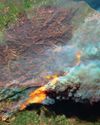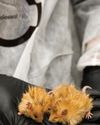Intentar ORO - Gratis
New Moons of Saturn
Muse Science Magazine for Kids
|March 2024
A NEW DISCOVERY IS CHANGING THE WAY WE THINK ABOUT THE MOONS IN OUR SOLAR SYSTEM.

Tiny, lumpy, and whizzing around their planet in all directions. And not just one or two of them, but an entire swarm. Welcome to the surprising new moons of Saturn.
Astronomer Edward Ashton led the team that recently discovered an astonishing 63 tiny new natural satellites orbiting around the sixth planet from the Sun. His findings pushed Saturn past Jupiter for the most moons in our solar system. No one has ever found this many moons before.
Ashton only located the new moons by breaking many of the unwritten rules about how and where to search for moons and how they should be expected to behave. He began this research while a graduate student at the University of British Columbia in Canada and now works at Academia Sinica Institute of Astronomy and Astrophysics in Taiwan. His discoveries may change the way we look at all moons-including our own.

Why Keep Searching?
Astronomers have been finding moons in orbit around Saturn for centuries. It began not long after the introduction of the telescope, which happened in 1608. Dutch science pioneer Christiaan Huygens discovered the first known moon of Saturn in 1655; it was named Titan.
By using ever-more powerful instruments over the years, astronomers found nearly a hundred more moons. So, why expect to find even more than that? "Based on a planet's size and other traits, we can estimate how the moons that orbit around that planet should vary in size and what percentage are big and small," Ashton explains. "For Saturn, smaller moons were still missing from the total."

Tough to Spot
Esta historia es de la edición March 2024 de Muse Science Magazine for Kids.
Suscríbete a Magzter GOLD para acceder a miles de historias premium seleccionadas y a más de 9000 revistas y periódicos.
¿Ya eres suscriptor? Iniciar sesión
MÁS HISTORIAS DE Muse Science Magazine for Kids

Muse Science Magazine for Kids
ANIMAL FIREFIGHTER TO THE RESCUE
Can animals help manage the risks of deadly wildfires?
3 mins
Muse July 2025: The Story Behind Wildfires

Muse Science Magazine for Kids
FIRE DANGER
WHY THE RISK OF WILDFIRES KEEPS GROWING
4 mins
Muse July 2025: The Story Behind Wildfires

Muse Science Magazine for Kids
The Miller NEW Normal
WHAT TODAY’S WILDFIRES TELL US ABOUT OUR FUTURE
8 mins
Muse July 2025: The Story Behind Wildfires

Muse Science Magazine for Kids
WOMEN AND FIREFIGHTING: A GOOD FIT
Jessica Gardetto is a firefighter. Her father was, too. “I grew up with my dad coming home smelling like wildfire and covered in soot,” she says.
1 min
Muse July 2025: The Story Behind Wildfires

Muse Science Magazine for Kids
What is happening on your fingertips when they get all wrinkly in a hot tub?
—Felix G., age 10, Montana
1 mins
Muse July 2025: The Story Behind Wildfires

Muse Science Magazine for Kids
WHEN the SMOKE CLEARS
THE LINGERING EFFECTS OF THE RECENT PACIFIC PALISADES AND ALTADENA EATON FIRES
6 mins
Muse July 2025: The Story Behind Wildfires

Muse Science Magazine for Kids
PICKING TEAMS
Keep it fair with a strategy that relies on geometry.
2 mins
Muse July 2025: The Story Behind Wildfires

Muse Science Magazine for Kids
SHAN CAMMACK
WILDLIFE BIOLOGIST AND FIRE SAFETY OFFICER
3 mins
Muse July 2025: The Story Behind Wildfires

Muse Science Magazine for Kids
Scientists Create Mice With Woolly Mammoth-Like Fur
RESEARCHERS AT A COMPANY IN TEXAS ARE WORKING TO CREATE A LIVING ANIMAL THAT RESEMBLES THE EXTINCT WOOLLY MAMMOTH. Recently, they produced mice with traits of the large mammal. The mice all have coats with mammoth-like fur, and some of the small mammals also have genes that help them store fat. Both features would help the animals survive in the cold Arctic, where the woolly mammoth once lived.
1 min
Muse July 2025: The Story Behind Wildfires

Muse Science Magazine for Kids
Cool Sunshade Added to the Nancy Roman Space Telescope
THE NANCY ROMAN SPACE TELESCOPE IS A NEW TELESCOPE THAT NASA IS BUILDING AND WILL LAUNCH INTO SPACE, LIKELY IN EARLY 2027.
1 min
Muse July 2025: The Story Behind Wildfires
Listen
Translate
Change font size
